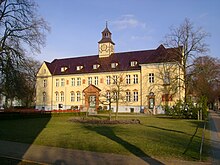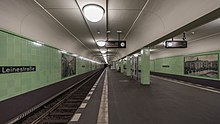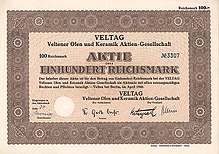Veltak

The Veltak (officially VVB glass-ceramic tile factory factory Veltak) was in the 1960s, the largest stove tile factory in Europe and was based in the Brandenburg town of Velten .
history

Veltak's predecessor was the stove factory Klaetsch & Kellermann , founded in 1871 at Friedrichstrasse 32 (today's Rosa-Luxemburg-Strasse) , which was taken over by master carpenter Sittel in 1880 and by Treuherz and Hermann Blumenfeld in 1884. His son Richard Blumenfeld took over the management of the factory in 1890. When it was converted into a stock corporation in 1905, he retained the chairmanship and took over other furnace factories in Velten over the years. In 1925 Richard Blumenfeld Veltener Ofenfabrik AG was the largest on-site oven factory. Richard Blumenfeld, who was in poor health, was forced to suspend the chairmanship of the corporation between 1930 and 1933.

Then, during the Nazi era , the Jewish entrepreneur was forced out of office as chairman of the stock corporation and the company was renamed Veltag, Veltener Ofen- und Keramik AG . At the beginning of the Second World War , the Veltag was classified as an important military operation. Nevertheless, the workforce and the number of skilled workers decreased. One consequence of this was that the quality fell and the delivery time for a tiled stove was two to four months, and later even more. Forced laborers from the Soviet Union were also used at the Veltag in 1944 .
After the war, the Veltag started production again despite partial dismantling by the Soviet authorities. But on January 1, 1947, it was expropriated, assigned to VEB Steine-Erden and later renamed VVB Glas-Keramik Werk Kachelfabrik Veltak . The meanwhile expanded location was Rosa-Luxemburg-Strasse 93-105. (former Friedrichstrasse) In 1968, the share of tiled stoves in heat generation in private households in the GDR was 84%. Accordingly, the state invested in Veltak in 1961, in which around 325 workers worked in shifts to produce 60 tons of stove tiles a day. This made it the largest tile factory in Europe. Special products, such as hand-painted stove tiles, were exported to Austria, Sweden or Canada in exchange for foreign currency .
The work was under the VEB Plattenwerk Max Dietel in Meissen and later to the political turn of the combine tiles and sanitary ware in Boizenburg / Elbe . In 1990 the name was changed to Veltak, Veltener Ofenkachel und Keramik GmbH , which in 1997 had to finally stop production. Most recently, 25 employees had worked there.
References
See also
literature
- Paul Dahms: Velten, A foray through the history of the furnace city , Veltener Verlagsgesellschaft mbH, ISBN 978-3-9811401-8-7 .
Individual evidence
- ↑ Paul Dahms: Velten, Ein Streifzug durch die Geschichte der Ofenstadt , pp. 91–94.
- ↑ Paul Dahms: Velten, Ein Streifzug durch die Geschichte der Ofenstadt , pp. 98–99.
- ↑ Paul Dahms: Velten, A foray through the history of the furnace city , pp. 108-109.
- ↑ Paul Dahms: Velten, A foray through the history of the furnace city , p. 111.
Coordinates: 52 ° 40 ′ 57.1 ″ N , 13 ° 10 ′ 43.1 ″ E
